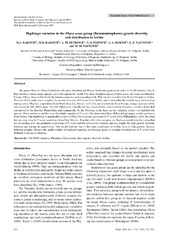Приказ основних података о документу
Haplotype variation in the Physa acuta group (Basommatophora): genetic diversity and distribution in Serbia
| dc.creator | Raković, Maja | |
| dc.creator | Raković, Marko B. | |
| dc.creator | Petrović, Anđeljko M. | |
| dc.creator | Popović, Nataša | |
| dc.creator | Đuknić, Jelena | |
| dc.creator | Naunovic, Zorana Z. | |
| dc.creator | Paunović, Momir | |
| dc.date.accessioned | 2017-02-23T14:52:48Z | |
| dc.date.available | 2017-02-23T14:52:48Z | |
| dc.date.issued | 2016 | |
| dc.identifier.issn | 1108-393X | |
| dc.identifier.uri | http://www.medit-mar-sc.net/index.php/marine/issue/view/52 | |
| dc.identifier.uri | https://radar.ibiss.bg.ac.rs/handle/123456789/2564 | |
| dc.description.abstract | The genus Physa (= Physella) includes the most abundant and diverse freshwater gastropods native to North America. Due to their invasive nature, many species occur throughout the world. The most abundant species, Physa acuta, has been introduced to Europe, Africa, Asia and Australia by human commerce and migrating birds. This species is widely distributed throughout Serbia. The aim of this study was to explore the genetic diversity of P. acuta from Serbia, and to determine the evolutionary relationships among native Physidae populations from North America, Mexico and Cuba and populations from Europe, using sequences of the mitochondrial 16S rDNA gene. The ML (Maximum Likelihood) tree revealed two clades within Physidae, and two clades that correspond to the families Planorbidae and Lymnaeidae. In the Physidae clade there are two separate clades: one includes the species Physa spelunca, and the second includes samples of P. acuta. We determined three different haplotypes within specimens from Serbia. One haplotype is genetically closest to Physa heterostrofa (synonym of P. acuta) from Philadelphia, while the other two are very close to P. acuta specimens from New Mexico. Together with other samples, our findings corroborate the notion that we are dealing with one panmictic population of P. acuta and not with several separate species, despite the high genetic diversity between and among the populations. Our results indicate that in the same population in Serbia, there is high genetic distance between samples. Despite the small number of analyzed samples, our findings point to multiple introductions of P. acuta from different locations in America. | en |
| dc.relation | info:eu-repo/grantAgreement/EC/FP7/603629/EU// | |
| dc.relation | info:eu-repo/grantAgreement/MESTD/Basic Research (BR or ON)/176018/RS// | |
| dc.relation | info:eu-repo/grantAgreement/MESTD/Basic Research (BR or ON)/173025/RS// | |
| dc.relation | info:eu-repo/grantAgreement/MESTD/Integrated and Interdisciplinary Research (IIR or III)/43001/RS// | |
| dc.rights | openAccess | |
| dc.rights.uri | https://creativecommons.org/licenses/by-nc-sa/4.0/ | |
| dc.source | Mediterranean Marine Science | |
| dc.subject | 16S rDNA variation | |
| dc.subject | Physidae | |
| dc.subject | Physa acuta | |
| dc.subject | Alien species | |
| dc.subject | Danube | |
| dc.subject | Serbia | |
| dc.title | Haplotype variation in the Physa acuta group (Basommatophora): genetic diversity and distribution in Serbia | en |
| dc.type | article | |
| dc.rights.license | BY-NC-SA | |
| dcterms.abstract | Петровић, Aнђељко М.; Ђукнић, Јелена; Раковић, Маја Ј.; Науновиц, Зорана З.; Поповић, Наташа З.; Пауновић, Момир; Раковић, Марко Б.; | |
| dc.rights.holder | © by the authors | |
| dc.citation.issue | 1 | |
| dc.citation.volume | 17 | |
| dc.identifier.doi | 10.12681/mms.1453 | |
| dc.identifier.scopus | 2-s2.0-85016333431 | |
| dc.identifier.wos | 000374469200024 | |
| dc.citation.apa | Raković, M. J., Raković, M. B., Petrović, A. M., Popović, N. Z., Đuknić, J. A., Naunovic, Z. Z., et al. (2016). Haplotype variation in the Physa acuta group (Basommatophora): genetic diversity and distribution in Serbia. Mediterranean Marine Science, 17(1), 292–301. | |
| dc.citation.vancouver | Raković MJ, Raković MB, Petrović AM, Popović NZ, Đuknić JA, Naunovic ZZ, Paunović MM. Haplotype variation in the Physa acuta group (Basommatophora): genetic diversity and distribution in Serbia. Mediterr Mar Sci. 2016;17(1):292–301 | |
| dc.citation.spage | 292 | |
| dc.citation.epage | 301 | |
| dc.type.version | publishedVersion | en |
| dc.identifier.fulltext | https://radar.ibiss.bg.ac.rs//bitstream/id/3635/MediterrMarSci_2016_17_1_292-301.pdf | |
| dc.citation.rank | M22 |

